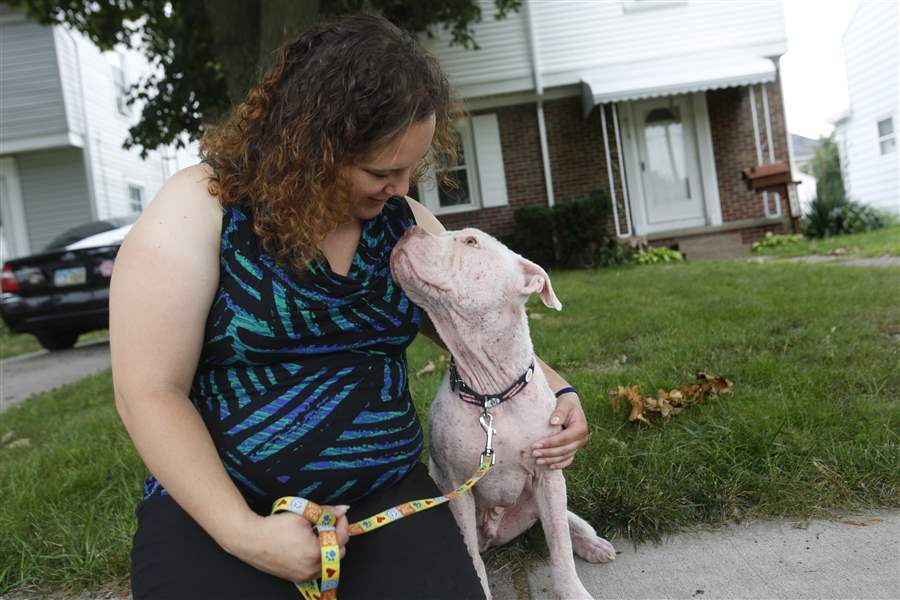
CRITTER CARE
Highly treatable, mange is only skin deep
Dog being fostered in Toledo not contagious
8/12/2013
Michelle Wasylecki of Toledo is fostering 6-month-old Audie, who has demodectic mange. With a regimen of medication and benzoyl peroxide baths, his skin should clear up in a few months.
The Blade/Katie Rausch
Buy This Image

Michelle Wasylecki of Toledo is fostering 6-month-old Audie, who has demodectic mange. With a regimen of medication and benzoyl peroxide baths, his skin should clear up in a few months.
Michelle Wasylecki is having a hard time getting anything done since she volunteered to foster Audie for Planned Pethood.
“All Audie wants me to do is spoon him while he sleeps,” said Ms. Wasylecki. “He is an angel.”
Ms. Wasylecki will look after the white “pit bull”-mix dog at her Toledo home for the next several months while he undergoes treatment for mange.
The 6-month-old dog was rescued from the Ottawa County dog warden. The skin infection is easily treatable, but it puts people off because they think it might be contagious, said Dr. Gary Thompson, a veterinarian at West Suburban Animal Hospital in Sylvania Township.
There are actually two types of mange, and the one Audie has — demodectic — is not contagious and is relatively common in young dogs, Dr. Thompson said. The contagious variation is called sarcoptic mange. It can be spread in dog-to-dog contact as well as to people.
“Sarcoptic mange only transiently affects people, but anyone living with a dog with sarcoptic mange should wash his or her hands thoroughly after interacting with the puppy,” Dr. Thompson said. “This type of mange is more difficult to diagnose because the mites burrow under the skin and only 50 percent of the time will they be detected on a skin scraping. Infected dogs are intensely itchy, and it can localize on lightly haired areas such as the tips of the ears, elbows, and belly. A couple of treatments can be used, and most commonly response to these treatments results in a diagnosis.”
To treat Audie’s demodectic mange — also called Demodex or demodicosis — Ms. Wasylecki is giving him ivermectin along with benzoyl peroxide baths a few times each week. “Demodex is a normal mite that lives in low numbers in the hair follicles,” Dr. Thompson said. “Stress, poor nutrition all suppress the immune system and allow for overgrowth of these mites.”
Hair loss and secondary skin infections are the typical manifestation of this overgrowth, he said.

Amitraz dips are the FDA-approved treatment, but most veterinarians use ivermectin (a common heartworm preventive) daily until the mites are not seen microscopically, he said.
“These mites are not contagious to other pets or people under any circumstances,” Dr. Thompson said. “Most puppies that are infected with Demodectic mange and make a full recovery will never have another bout. It is thought that a window exists developmentally with the puppy’s immune system that allows this mite to get a foothold and proliferate.”
Older animals who come down with mange usually suffer from another ailment, Dr. Thompson said.
“Demodectic mange in an older animal is always a secondary problem, and the primary issue needs to be addressed,” he said. “It almost always suggests a more serious underlying disease that is suppressing the immune system.”
In Audie’s case, he’s just young and likely didn’t have the best nutrition or care before he was dropped off at the pound.
“I named him Audie because it meant ‘gracious,’ which I’m sure he is,” Ms. Wasylecki said. Despite the severe pain he’s going through, he’s still the sweetest little boy I have ever met.”
The dog will be available for adoption in about two months, she said. He is good with other dogs and cats.
The easy-going dog has to wear a shirt to protect his sores and also boots on his paws to prevent him from scratching them open.
“He already knows sit, down, shake, stay, and come,” Ms. Wasylecki said. “Other than his skin, he is 100 percent perfect!”
Anyone interested in adopting Audie can fill out an application on Planned Pethood’s Web site at tinyurl.com/AdoptAudie.
Contact Tanya Irwin at: tirwin@theblade.com, 419-724-6066, or on Twitter @TanyaIrwin.